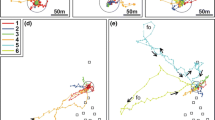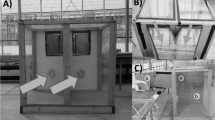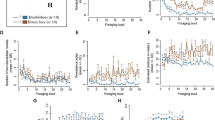Abstract
Bumblebees move about their environments by flying and by walking. Most experimental studies have addressed navigation during foraging flights, but we presented our experimental bees with the challenge of learning to navigate while walking as they must do in nature within topographically complex spaces containing their nests. We trained bumblebee workers to navigate complex, nine-channel, mazes in the absence of specific visual, chemical or textural cues. They successfully navigated through complex multi-turn mazes (stereotypical “rat mazes”) with several dead-ends by memorizing the entire sequence of appropriate turns, and their choice of correct first turn on entering the maze. Thus, their observed proficiencies indicated that the individual bumblebees had each memorized the maze by learning motor sequences which were not linked to visual, chemical or textural stimuli, and that their memories were triggered by contextual cues associated with the bees’ positions in a sequence. Our findings have implications on natural ambulatory activities inside and outside the colony, and even in practical use as vectors of biological control agents.





Similar content being viewed by others
References
Anderson JR (2000) Learning and memory an integrated approach (second edition). Wiley, Carnegie Mellon University
Baerends GP (1941) Fortpflanzungsverhalten und Orientierung der grabwespe Ammophila campestris Jur. Zietschrifte für Entomologie 84:81–275
Bernstein S, Bernstein RA (1969) Relationship between foraging efficiency and the size of the head and component. Brain Res 16:85–104
Bicker G, Spatz HC (1976) Maze-learning ability of Drosophila melanogaster. Nature 260:371
Cameron SA (1985) Brood care by male bumble bees. Proc Natl Acad Sci U S A 82:6371–6373
Cameron SA, Whitfield JB (1996) Use of walking trails by bees. Nature 379:125
Cartron L, Darmaillacq SA, Jozet-Alves C, Shashar N, Dickel L (2012) Cuttlefish rely on both polarized light and landmarks for orientation. Anim Cogn 15: 591–596
Chameron S, Schatz B, Pastergue-Ruiz I, Beugnon G, Collett TS (1998) The learning of a sequence of visual patterns by the ant Cataglyphis cursor. Proc R Soc Lond B Biol Sci 265:2309–2313
Chittka L (1998) Sensorimotor learning in bumblebees: long-term retention and reversal training. J Exp Biol 201:515–524
Chittka L, Thomson JD (1996) The ecology of bumble bees in T- mazes. In: Gőttingen Neurobiology Report. Elsner N, Schnitzler H. (eds). Thieme, Stuttgart, p 130
Chittka L, Thomson JD (1997) Sensori-motor learning and its relevance for task specialization in bumble bees. Behav Ecol Sociobiol 41:385–398
Chittka L, Kunze J, Geiger K (1995) The influences of landmarks on distance estimation of honeybees. Anim Behav 50:23–31
Collett TS (1992) Landmark learning and guidance in insects. Philos Trans R Soc Lond Ser B Biol Sci 337:295–303
Collett TS, Baron J (1995) Learnt sensori-motor mappings in honeybees: interpolation and its possible relevance to navigation. J Com Physiol Series A 177:287–298
Collett TS, Zeil J (1998) Place and landmarks: An arthropod perspective. In: Spatial Representation in Animals (ed. S. Healy), pp. 18–53. Oxford University Press, Oxford
Collett TS, Dillmann E, Giger A, Wehner R (1992) Visual landmarks and route following in desert ants. J Comp Physiol, Series A 170:435–442
Collett TS, Fry SN, Wehner R (1993) Sequence learning by honeybees. J Com Physiol Series A 172:693–706
Corbet SA, Kerslake CJC, Brown D, Morland NE (1984) Can bees select nectar-rich flowers in a patch? J Apic Res 23:234–247
Dale RHI (1988) Spatial memory in pigeons on a four-arm radial maze. Can J Psychol 42:78–83
Dyer AG, Whitney HM, Arnold SEJ, Glover BJ, Chittka L (2007) Mutations perturbing petal cell shape and anthocyanin synthesis influence bumblebee perception of Antirrhinum majus flower colour. Arthropod Plant Interact 1:45–55
Dyer AG, Spaethe J, Prack S (2008) Comparative psychophysics of bumblebee and honeybee colour discrimination and object detection. J Com Physio, Series A 194:617–627
Free JB (1987) Pheromones of social bees. Chapman and Hall, London, UK
Free JB, Butler CG (1959) Bumblebees. Collins, London
Gallistel CR (1990) The cognitive map. In: Gallistel CR (ed) The organisation of learning. MIT Press, Cambridge, pp 103–172
Goetsch W (1957) The Ants. The University of Michigan Press
Goulson D (2010) Bumblebees: behaviour, ecology, and conservation. Oxford University Press, Oxford
Goulson D, Stout JC, Langley J, Hughes WHO (2000) Identity and function of scent marks deposited by foraging bumblebees. J Chem Ecol 26:2897–2911
Han P, Niu C, Lei C, Cui J, Desneux N (2010) Use of an innovative T-tube maze assay and the proboscis extension response assay to assess sublethal effects of GM products and pesticides on learning capacity of the honey bee. Apis mellifera L Ecotoxicol 19:1612–1619
Hay DA (1975) Strain differences in maze-learning ability of Drosophila melanogaster. Nature 257:44–46
Healy S (1998) Spatial Representation in Animals. Oxford University Press, Oxford
Heinrich B (1976) Foraging specialisations of individual bumblebees. Ecol Monogr 46:105–128
Honzik CH (1936) The sensory basis of maze learning in rats. Com Psychol Monog 13:113
Janzen DH (1971) Euglossine bees as long distance pollinators of tropical plants. Science 171:203–205
Keasar T, Motro U, Shur Y, Shmida A (1996) Overnight memory retention of foraging skills by bumblebees is imperfect. Anim Behav 52:95–104
Kevan PG (1979) Floral colors in the high arctic with reference to insect–flower relations and pollination. Can J Bot 50:2289–2316
Kevan PG (1979) The spectral efficiency of phototaxis for some high Arctic Diptera. Arct Alp Res 11:349–352
Kevan PG, Lane MA (1985) Flower petal microtexture is a tactile cue for bees. Proc Natl Acad Sci U S A 80:4750–4752
Kevan PG, Kapongo JP, Al-Mazra’awi M, Shipp L (2008) Honey bees, bumble bees, and biocontrol. In: Bee Pollination in Agricultural Ecosystems (eds James, RR, Pitts-Singer TL). Oxford University Press. Pp. 65 – 79.
Kevan PG, Shipp L, Thomas VG (2014) Using pollinators for crop protection. Int Innov 125:9–11
Lehrer M, Horridge GA, Zhang SW, Gadagkar R (1995) Shape vision in bees: Innate preference for flower-like patterns. Philos Trans R Soc Lond B 347:123–137
Lihoreau M, Raine NE, Reynolds AM, Stelzer RJ, Lim KS, Smith AD, Osborne JL, Chittka L (2012) Radar tracking and motion-sensitive cameras on flowers reveal the development of pollinator multi-destination routes over large spatial scales. PLoS Biol 10(9), e1001392
Martin H (1965) Leistungen des topochemischen Sinnes bei der Honigbiene. Zeitsehrift fiir vergleichende Physiologie 50:254–292
McConnell JV (1966) The Worm Runner’s Digest. The Sciences 6(7): 19–23
Menzel R (1981) Achromatic vision in the honeybee at low light intensities. J Comp Physiol Series A 141:389–393
Menzel R (1990) Learning, memory and ‘cognition’ in honey bees. In: Kesner RP, Olten DS (eds) Neurobiology of Comparative Cognition. Erlbaum Inc., Hillsdale, NJ, pp 237–292
Mirwan HB, Kevan PG (2014) Problem solving by worker bumblebees Bombus impatiens (Hymenoptera: Apoidea). Anim Cogn. doi:10.1007/s10071-014-0737-0
Muller M, Wehner B (1988) Path integration in desert ants, Cataglyphis fortis. Neurobiology 85:5287–5290
Munn NL (1950) The role of sensory processes in maze behavior. In: Handbook of Psychological Research on the Rat, (Munn NL). Houghton Mifflin, Boston, pp 181–225
Ohashi K, Thomson JD (2012) Trapline foraging by bumble bees: VI. Behavioral Alter Under Speed-Accuracy Trade-offs Behav Ecol 24:182–189
Olton DS (1977) Spatial memory. Sci Am 236(6):82–98
Pick CG, Yanai J (1983) Eight arm maze for mice. Int J Neurosci 21:63–66
Platt SA, Holliday M, Drudge OW (1980) Discrimination learning of an instrumental response in individual Drosophila melanogaster. J Exp Psychol Anim Behav Process 6:301–311
Plowright CMS, Simonds VM, Butler MA (2006) How bumblebees first find flowers: Habituation of visual pattern preferences, spontaneous recovery, and dishabituation. Learn Motiv 37:66–78
Quinn WG, Harris WA, Benzer S (1974) Conditioned behavior in Drosophila melanogaster. Proc Natl Acad Sci U S A 71:708–712
Raine NE, Chittka L (2008) The correlation of learning speed and natural foraging success in bumblebees. Proc Royal Soci London Series B-Biolog Sci 275:803–808
Reynolds AM, Lihoreau M, Chittka L (2013) A simple iterative model accurately captures complex trapline formation by bumblebees accross spatial scales and flower arrangements. PLoS Comput Biol 9, e1002938
Ritter, FE & Schooler LJ (2002) The learning curve. In International encyclopedia ofthe social and behavioral sciences. 8602–8605. Amsterdam: Pergamon. http://www.iesbs.com/
Rosengren R (1971) Route fidelity, visual memory and recruitment behaviour in foraging wood ants of the genus Formica (Hymenoptera, Formicidae). Acta Zool Fenn 133:1–106
Saleh N, Scott AG, Bryning GP, Chittka L (2007) Distinguishing signals and cues: bumblebees use general footprints to generate adaptive behaviour at flowers and nest. Arthropod Plant Interact 1:119–127
SAS (Statistical Analaysis Software) (2014) www.sas.com/en_us/software/analytics/stat.html (accessed 11 September, 2014)
Schneirla TC (1929) Learning and orientation in ants. Comparative Psychology Monographs 6:1–143
Schneirla TC (1941) Social organization in insects, as related to individual function. Psychol Rev 48:465–486
Séguin FR, Plowright CMS (2008) Assessment of pattern preferences by flower-naïve bumblebees. Apidologie 39:215–224
Sladen FWL (1912) The humble-bee its life history and how to domesticate it. With description of all British species of Bombus and Psithyrus. Macmillan & Co., Ltd
Tierney AJ; Andrews K (2013) Spatial behavior in male and female crayfish (Orconectes rusticus): learning strategies and memory duration. Anim Cogn 16:23–34
Thomson JD, Slatkin M, Thomson BA (1997) Trapline foraging by bumblebees definition and detection from sequence data. Behav Ecol 8:199–210
Thorpe WH (1950) A note on detour experiment with Ammophila pubescens Curt. (Hymenoptera; Sphecidae). Behaviour 13:257–263
Tully T (1984) Drosophila learning: Behavior and biochemistry. Behav Genet 14:527–557
Vygotsky LS (1987) Thinking and speech. In L. S. Vygotsky, Collected works (1: pp. 39–285) (R. Rieber & A. Carton, Eds; N. Minick, Trans). New York: Plenum. (Original works published in 1934, 1960).
Wehner R (1992) Arthropods. In: Papi F (ed) Animal Homing. Chapman & Hall, London, pp 45–144
Wehner R, Menzel R (1990) Do insects have cognitive maps? Annu Rev Neurosci 13:403–414
Wehner R, Michel B, Antonsen P (1996) Visual navigation in insects: coupling of egocentric and geocentric information. J Exp Biol 199:129–140
Weiss K (1953) Versuche mit Bienen und Wespen in farbingen Labyrinthen. Zeitschifte für Tierpsychologie 10:29–44
Wilms J, Eltz T (2008) Foraging scent marks of bumblebees: footprint cues rather than pheromone signals. Naturwissenschaften 95:149–153
Wilson EO, Hölldobler B (1990) The ants. Springer, Berlin Heidelberg
Zhang SW, Bartsch K, Srinivasan MV (1996) Maze learning by honeybees. Neurobiol Learn Mem 66:267–282
Zhang SW, Lehrer M, Srinivasan MV (1998) Stimulus- conditioned sequence learning in honeybees. In: Proceedings of the 26th Goettingen Neurobiology Conference 1998 (eds Elsner N and Wehner R), 2: 519. Stuttgart: Thieme
Zhang SW, Lehrer M, Srinivasan MV (1999) Honeybee memory: navigation by associative grouping and recall of visual stimuli. Neurobiol Learn Mem 72:180–201
Zhang S, Mizutani A, Srinivasan MV (2000) Maze navigation by honeybees: learning path regularity. Learn Mem 7:363–374
Acknowledgments
We thank the Ministry of Higher Education, Libya, Canadian Bureau for International Education, Ottawa, Canada, and the Canadian Pollination Initiative (NSERC-CANPOLIN for which this is contribution No. 128) for funding. We thank Dr. Sarah Bates (NSERC-CANPOLIN, University of Guelph) for her help in preparing this paper. BioBest Canada, Leamington, Ontario kindly provided the colonies of Bombus impatiens for our study.
Author information
Authors and Affiliations
Corresponding author
Rights and permissions
About this article
Cite this article
Mirwan, H.B., Kevan, P.G. Maze Navigation and Route Memorization by Worker Bumblebees (Bombus impatiens (Cresson) (Hymenoptera: Apidae). J Insect Behav 28, 345–357 (2015). https://doi.org/10.1007/s10905-015-9507-3
Revised:
Accepted:
Published:
Issue Date:
DOI: https://doi.org/10.1007/s10905-015-9507-3




